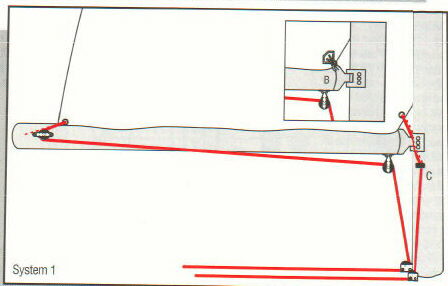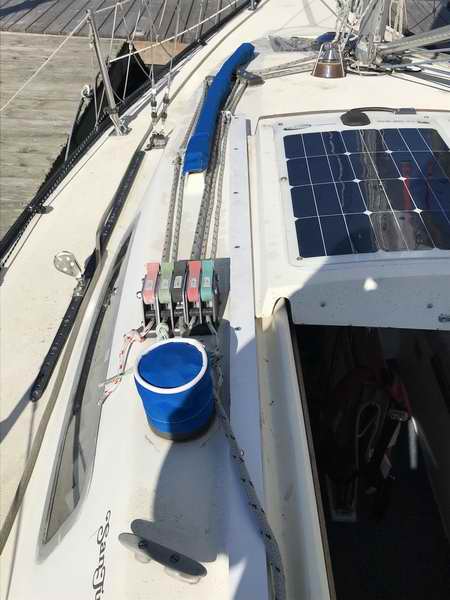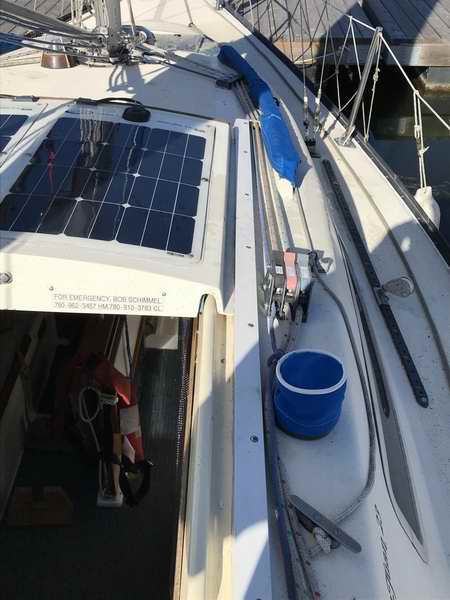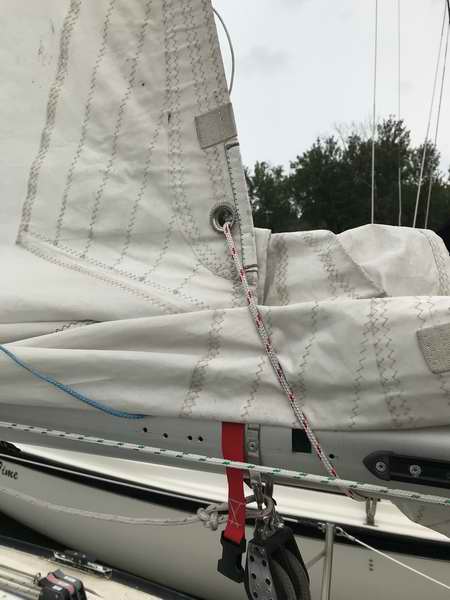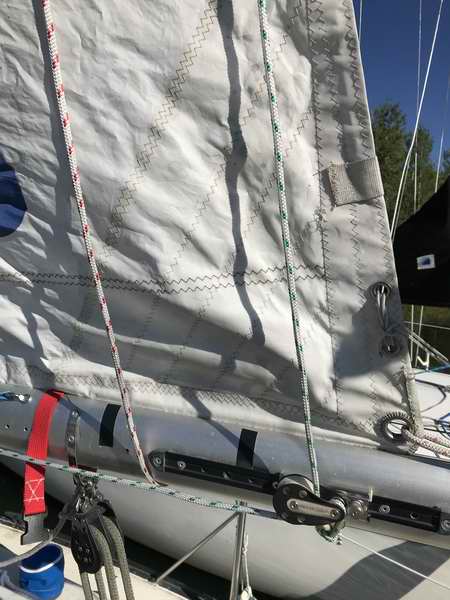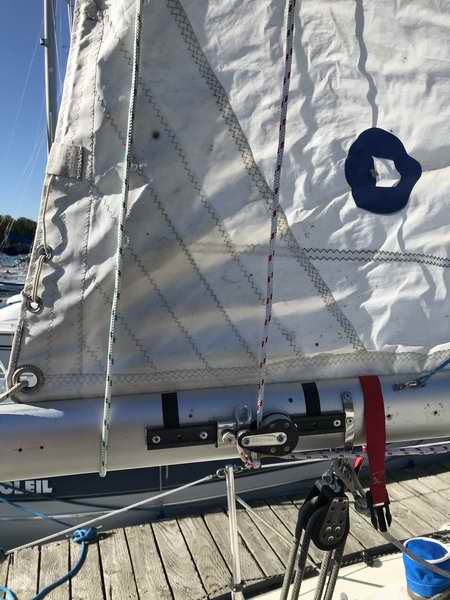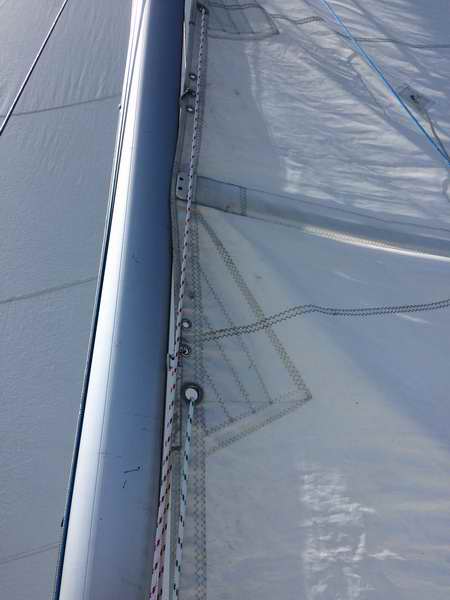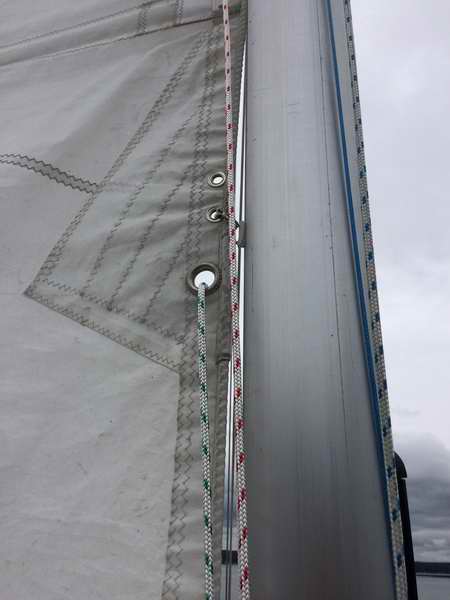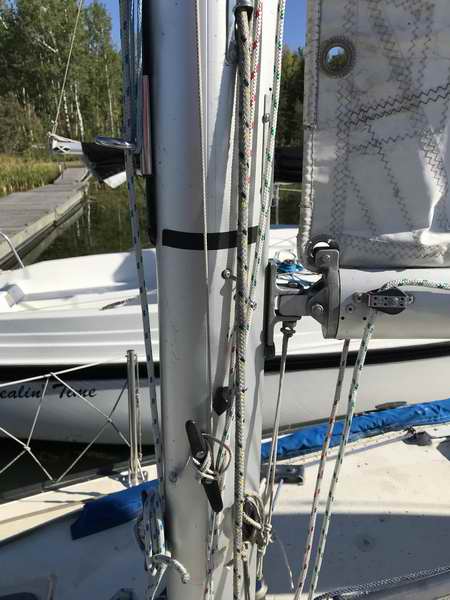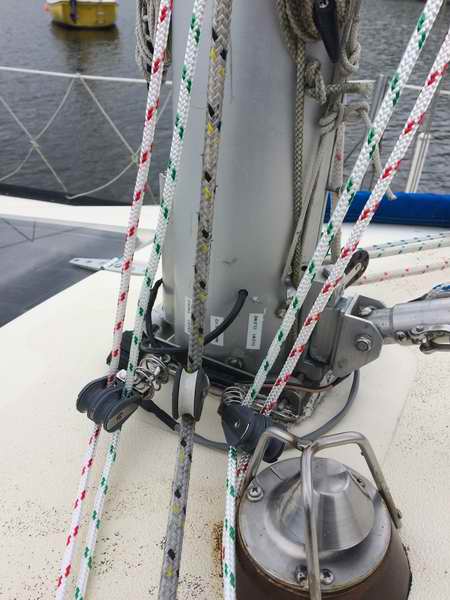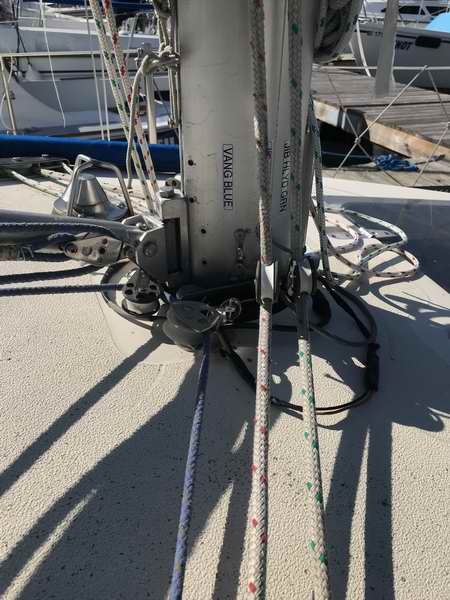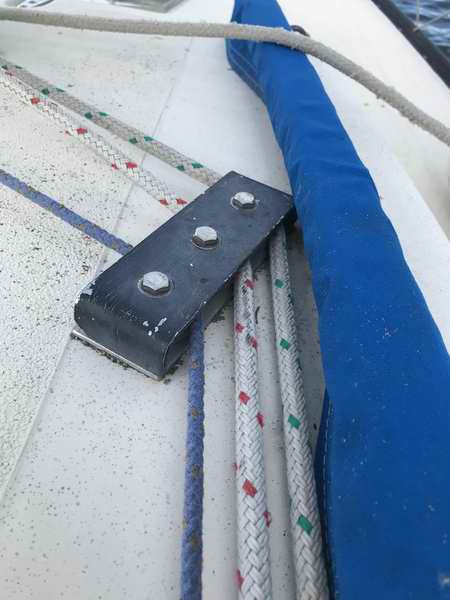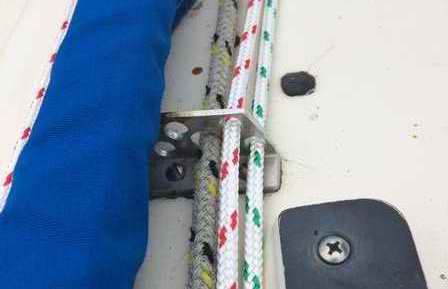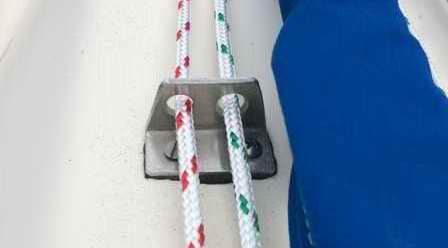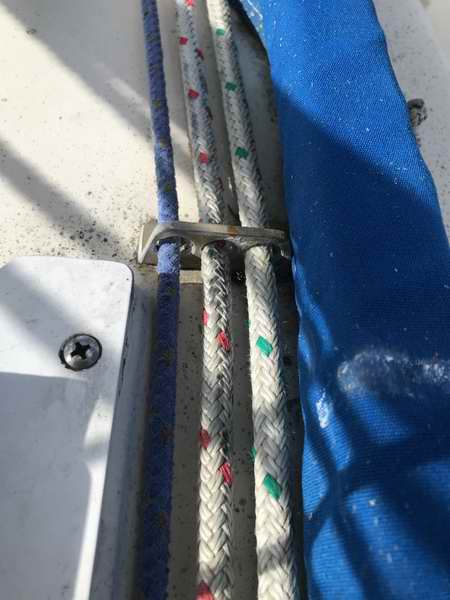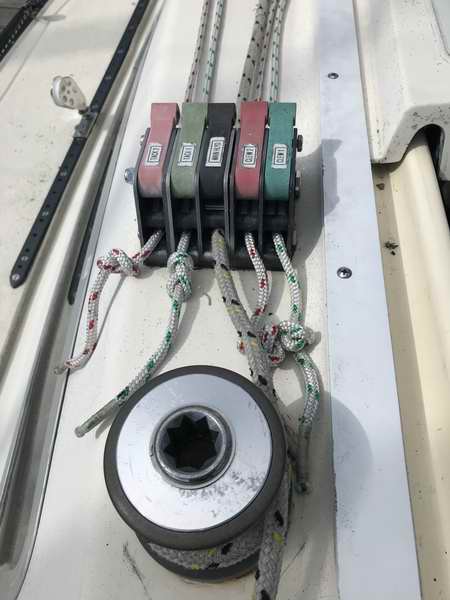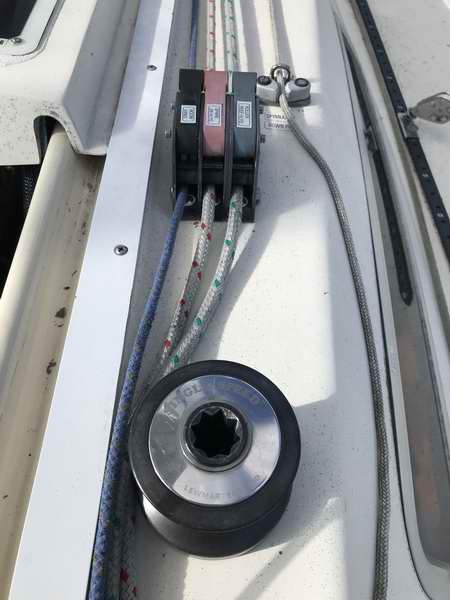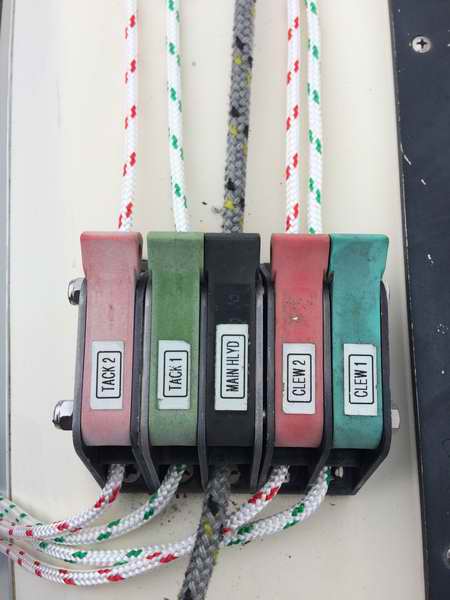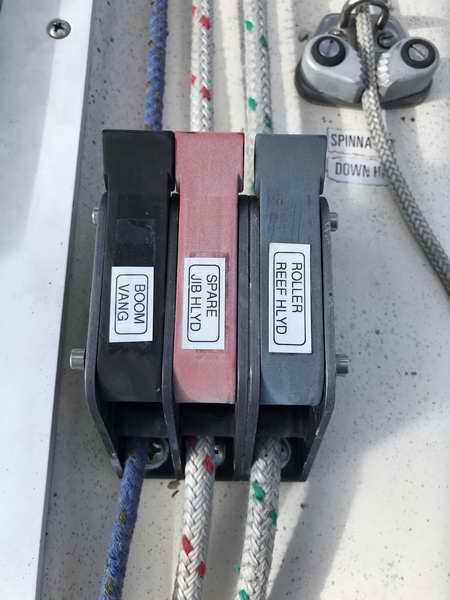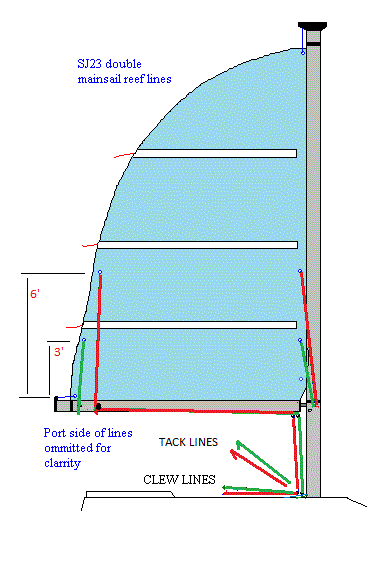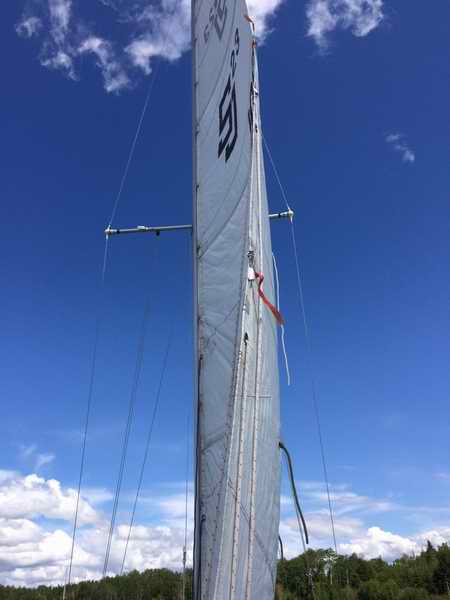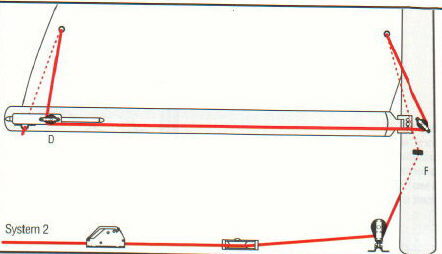| SJ23 Tech Tip F05, (Updated 2023-09-10) B. Schimmel | |||||||||||||||||||||||||||||||||||||||
|
Mainsail Reefing Systems - Dual Line, Reef Procedure and Single Line, Reef Procedure. |
|||||||||||||||||||||||||||||||||||||||
| Most sailors will stay in protected water or at the dock during lousy
weather claiming they don't have decent reefing on the mainsail.
Staying put is OK until you get caught out there having to deal with what Mother nature hands out to you. Being able to reef the mainsail quickly is
sort of important when the weather turns nasty!
This is a time for acting, not thinking. Reef early and reef often is a fundamental safety procedure. I'm always impressed that Panache goes just as fast reefed and with more control.
The factory reefing configuration works OK but a crew has to go to the mast to set the first reef tack cringle on the ram's horn hook and then pull the clew line in. The problem with this system is that the mainsail has to be dropped out of its track. The trip to the mast must be coordinated with the helmsman. Reefing is usually easier with crew on board but I wouldn't count on them if they are green horns. You can only watch anxious crew dance around on the coach roof for so long, entertaining as they may be, before you have to do something and quick! Sailing in heavy weather can humble a crew and sailing solo usually adds a few twists that you may not have thought of. Staying within the safety of the cockpit helps to avoid risks, which means the reefing lines must be extended to the cockpit. This demands that the system be well engineered and the process well thought through, unless you enjoy entertaining as well! To determine which reefing system you want on your boat you have to decide where you want to control the lines lead to; cockpit, mid boom or mast. Described here are two typical cockpit lead mainsail reefing systems that can be installed on an SJ23. There are variations of these that tend to be complicated but I prefer a simple and functional system. If you are unsure which one to choose, try using the system on a similar boat. That way you can experience the pros and cons before you spend your hard earned cash or perforate your boom with unnecessary holes. The biggest hurdle to overcome is not pulling in the reef, but releasing it. That is why some people opt to keep the free ends of the reefing lines on the boom. It has the least internal resistance, is the cheapest to install but requires you to crawl to the mast to adjust the lines. I prefer to stay in the cockpit when I'm sailing solo which is why I lead the lines to the cockpit. Having installed and used the single line system I can tell you that the dual line system works way better, which is why I mention it first. DUAL LINE REEFING SYSTEM, (Separate Tack and Clew Lines for each Reef Point) - The biggest advantages of a dual line system is that it has the least internal friction and the tack and clew lines can be controlled independently, making it easier to use than the single line system. The dual line system is depicted below, mainsail hoisted on the left and reefed on the right. For the sake of simplicity the lines for the second reef are not shown but they are shown in bottom of the table below. The clew block (marked A on the boom) is positioned so the reef line intersects the strain (reefed sail) at about 450. If the position of the SJ23 boom on the mast is fixed then the tack eyelet should be positioned on the mast, a few inches below the bottom of the boom. This intersects the strain at about 600 (reefed sail) with most of the force being upward along the luff. The tack cringle will slide across the tack reef line when the boom swings, therefore it is OK to leave a bit of slack when the tack line is set. A perfectly packed, efficient sail isn't required for a reef since there is too much wind anyway. However, you should flatten the sail with foot tension as much as possible to reduce lift. If you want to slide the SJ23 boom down the mast in heavy weather then the tack line fairleads must be installed on the boom instead of the mast. In this case you will have to mount the fairleads as far forward on the boom as possible. This configuration isn't that conducive to efficient reefing. I far prefer the boom to be fixed with the fairleads mounted on the mast. Your choice.
The lines of each reef should be colour coded to differentiate between reef 1 & 2. Its a "good" thing to pull the correct one, the first! For the same reason the rope clutches or cleats should be labelled (tack 1 / clew 1). Of less significance is the colour of the mid tie down lines on the mainsail. CUNNINGHAM LINE - This mainsail flattening line is not shown in the drawing above because the drawing would become too cluttered. The cunningham cringle is about 6" above the tack. Look closely and you'll see it. There are several ways to pull this cringle down to flatten the mainsail. You could run a permanent line through it similar to a tack reefing line. I prefer to slip a stainless tack hook (with line attached) through the cunningham cringle then pull it down and secure it around a cleat on the mast. This extra tension flattens (depowers) the mainsail to match higher wind speed. It is a useful technique for racing where a tenths of a knot may allow you to sail faster. When cruising I seldom bother with the cunningham unless the wind blows not quite hard enough to reef. The cunningham should be used in conjunction with matching outhaul tension to depower the main. I do like to sail as fast as possible. TACK LINES - As mentioned above you have to determine if the tack lines on your boat are to be attached to the mast (shown on diagram) or to the boom. Regardless of which location, the dead end of a tack line is tied to an eye strap on one side, passes up through its respective cringle and down the opposite side through an eye strap and finally down to the turning blocks at the base of the mast if you want to terminate the line in the cockpit. Since the majority of the sail cloth is bundled on top of the boom it is important to keep the lines away from the cloth so they slide freely. This is why many people prefer to install the tack lines on the mast instead of the boom. I transferred Panache's lines from the boom to the mast for the same reason. Line length Tech Tip F03. CLEW LINES - The dead end of each clew line is tied to the pin on the turning block installed on the boom. From there it goes under the boom and up to its respective clew cringle, then back down through the same turning block on the boom. This balances the load on this turning block and creates a 2:1 mechanical advantage for pulling sail cloth. With the reefing line under the boom it also transfers some of the load to the boom. Since there is limited space to install two turning blocks on the same side of the boom, the block for the second reef is installed on the opposite side. The clew lines then go forward to turning blocks mounted on the front of the boom at the goose neck. This greatly reduces the internal friction of the clew line since it can align with the direction of the pull to the deck block as the boom swings. Line length Tech Tip F03.
I hope this explains the rational
behind the dual line reefing system. Each tack and clew line terminates
in its respective rope clutch installed back at the cockpit. The
alternative is to install it on the boom. Your choice. |
|||||||||||||||||||||||||||||||||||||||
HISTORY - In 2014 I replaced my single line reef system with a dual line system experimenting with some old 1/4" polyester line. My single line system didn't work. Once the tack cringle was down to the boom I couldn't pull the clew down due to too much friction in the system. An SJ23 has very narrow deck space to install reefing lines lead back to the cockpit so the design is very particular. I did a trial installation of my dual line system using the single line blocks and discovered it worked way better than the single line. The first time I demonstrated the trial system I set and released both reefs in five minutes; would have been quicker if I didn't have to explain! Click here for a description of how the system works. Later I installed separate blocks and rope clutches for each line as shown in the photos below. Line length is described in Tech Tip F03. By 2019 my polyester reefing lines were getting old and difficult to release. Ironically releasing a reef quickly is the test of a good system so it was time to replace the lines. This time I chose 1/4" (6MM) line, green for reef 1 & red for reef 2 to match the green and red rope clutches. While it is tempting to use 1/8" slippery single braid Dyneema line, it would just be my luck that I would slice my wet hands open when pulling it. So I installed 1/4" (6MM) line which is the minimum size a person should handle without wearing sail gloves. See Tech Tip F03. Dyneema doesn't exhibit torque loading, making it perfect for all the right angle turns it has to go through. When shaking out a reef I usually hoist the mainsail with the winch to pull the Dyneema lines through the deck hardware. Sometimes the load is too much and have to feed the lines at the mast. Unfortunately the 1/4" (6MM) Dyneema line with the slippery jacket creeps slightly through Panache's rope clutches so I thickened the line where it is gripped. Where to bulk the line up and for how long was determined with the mast standing to make accurate measurements. Splicing a piece of 1/8" line inside another line is a clever technique that creates tapered ends that easily slide through a block. I spliced it using a 1' length of coat hanger wire, a wrap of fibreglass tape, some coconut oil for a washable lubricant, and then zigzag stitched through both to make them as "one." The advantage is smooth operation, minimal wear and when the thick portion is in the line clutch you know the sail cringle is down correctly. https://www.berkeleypoint.com/learning/singlebraid.html. There are two alternatives:
NOTE - In my tests of using 1/8" Dyneema line to reef the mainsail I determined that it griped well in
a dual or single cam cleat and around a rough finished deck cleat. What a surprise since this small size line is the most difficult to grip. It failed miserably over a polished cleat as I could easily pull
3 wraps of line off that cleat.
REEFING PROCEDURE - Usual reefing procedure for Panache's 2 lines system is as follows:
Here are some extra tips you might find useful.
SEASON START -
Each clew line is tied to the block pin at the end of
the end of boom. From there the lines go under the boom, up to the cringle, down to the block and forward to the blocks at the end of the boom, down to the deck turning blocks, to end at the rope clutches on the deck. WINTER STORAGE - At haul out time I will pull the clew and tack reef lines out of the deck blocks and bundle them under the mainsail straps on the boom. The intention is to keep the reef lines with the boom during winter. I store my full batten mainsail on the boom over winter, wrapped in the mainsail cover with straps relaxed. The load is spread over several cushions to make it easy on things. At launch time I unbundle the reef lines from the boom and run them through the deck blocks to the rope clutches. Straight forward organization. _______________________________________________
The usual reefing procedure for a single line system is as follows:
___________________________________________ There are many variations of these two systems. Some
sailors will dispense with leading the lines to the cockpit, preferring to
terminate
them on the front of the boom or on the mast. While this system
works well, it necessitates going to the mast which may be difficult
in rough water if you sail solo. In this case you better have
a tiller tamer, auto pilot or be very quick! Years ago I used this technique on
my previous boat but usually delayed the trip to the mast hoping that
the wind would subside. It almost never did! NOTE: I borrowed the diagrams from the nice folks at Harken. |
|||||||||||||||||||||||||||||||||||||||
|
Return to Tech Tip Index. . . . . . . . . . . . . . . Have a Question? |
|||||||||||||||||||||||||||||||||||||||

